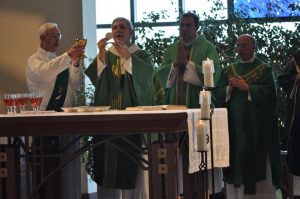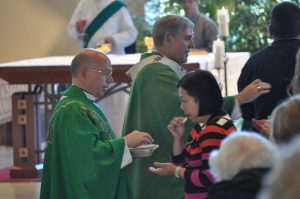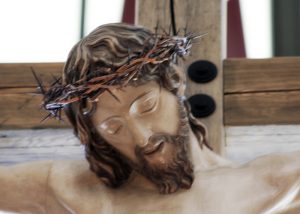In this week’s blog, “how we pray” is the theme, focusing on The Sign of the Cross, which is one of the most ancient Christian ‘formulas’, reflecting the Trinity, contained already in the New Testament and in the writings of St. Paul. The Sign of the Cross is a physical shape that represents the very core of the message of salvation; it directs us towards the saving work of Jesus Christ; the words we say as we make the sign of the Cross remind us of the doctrine of the Trinity. The Catechism of the Catholic Church delves more deeply into prayer to the Father, Son and Holy Spirit in sections 2664-2670. Below, Shelley Burnett shares her own witness on the responsibility of teaching our children this beautiful prayer that is core to our faith. Shelley, a former English teacher and now, full-time mother, resides in Bristol with her husband, Dan, along with their three young children.
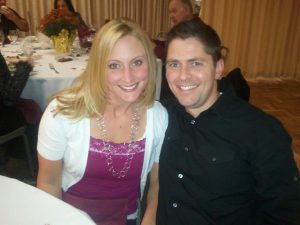 When I was in college studying education, they told us that a person understands things best when she has to teach it to others. I found that to be true in my job as a teacher (let me tell you about dangling participles), but also in my role as a mother. Being a parent is all about teaching – the hows and whys, rights and wrongs, and ins and outs of life. And as a parent, often times, “Because,” is just not enough of an answer to the questions of young ones.
When I was in college studying education, they told us that a person understands things best when she has to teach it to others. I found that to be true in my job as a teacher (let me tell you about dangling participles), but also in my role as a mother. Being a parent is all about teaching – the hows and whys, rights and wrongs, and ins and outs of life. And as a parent, often times, “Because,” is just not enough of an answer to the questions of young ones.
One of the things we have been recently trying to teach 2-year-old Gavin is how to make the Sign of the Cross. Currently, it involves repeatedly smacking his forehead and chest. On the other hand, 5-year-old Noah, has mastered the motions. Now it is time to move on to teaching him about its significance. And this is definitely not on of those questions where, “because” is an acceptable response.
 It’s amazing how children can force us to delve deeper into things. It’s so easy to let something that is routine remain just that – routine. The Sign of the Cross is one of those things that we do so often it could easily (and sometimes does, if I’m being truthful) lose the significance that it possesses. Or perhaps I sometimes fail to take the time to give it the value it deserves. I make the sign, speak the words, but is it an active or passive gesture? I understand it’s significance, but do I really let that wash over me every time I make the Sign of the Cross?
It’s amazing how children can force us to delve deeper into things. It’s so easy to let something that is routine remain just that – routine. The Sign of the Cross is one of those things that we do so often it could easily (and sometimes does, if I’m being truthful) lose the significance that it possesses. Or perhaps I sometimes fail to take the time to give it the value it deserves. I make the sign, speak the words, but is it an active or passive gesture? I understand it’s significance, but do I really let that wash over me every time I make the Sign of the Cross?
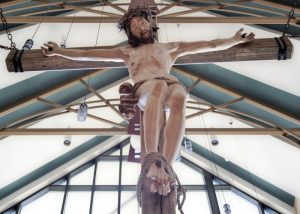 So now I am in the midst of trying to reacquaint myself with everything that this symbol is. I learned some new things in my explorations. The Sign of the Cross isn’t mentioned in the Bible or the Catechism of the Catholic Church in a literal sense. However, the Catechism does talk of the way of prayer, which directly relates to the trinity we invoke through the Sign of the Cross. First, prayer only has access to the Father if we pray “in the name” of Jesus. In praying to Jesus, we are invoked to follow the way of the cross. Finally, the Holy Spirit, Master of Christian prayer, draws us into prayer and teaches us to pray through Christ Jesus.
So now I am in the midst of trying to reacquaint myself with everything that this symbol is. I learned some new things in my explorations. The Sign of the Cross isn’t mentioned in the Bible or the Catechism of the Catholic Church in a literal sense. However, the Catechism does talk of the way of prayer, which directly relates to the trinity we invoke through the Sign of the Cross. First, prayer only has access to the Father if we pray “in the name” of Jesus. In praying to Jesus, we are invoked to follow the way of the cross. Finally, the Holy Spirit, Master of Christian prayer, draws us into prayer and teaches us to pray through Christ Jesus.
Funny how a symbol not mentioned elsewhere has become so ingrained into our prayer tradition. What powerful symbolism it holds, reminding us of the Holy Trinity, the Cross on which our redeemer willingly hung to save us from sin, and serving as a reminder of the crosses in our own lives. Then he said to them all: Whoever wants to be my disciple must take up their cross and follow me (Luke 9:23).
 I now endeavor to make the Sign of the Cross intentionally, not simply out of habit. And I hope to teach my children the power and significance it holds.
I now endeavor to make the Sign of the Cross intentionally, not simply out of habit. And I hope to teach my children the power and significance it holds.


